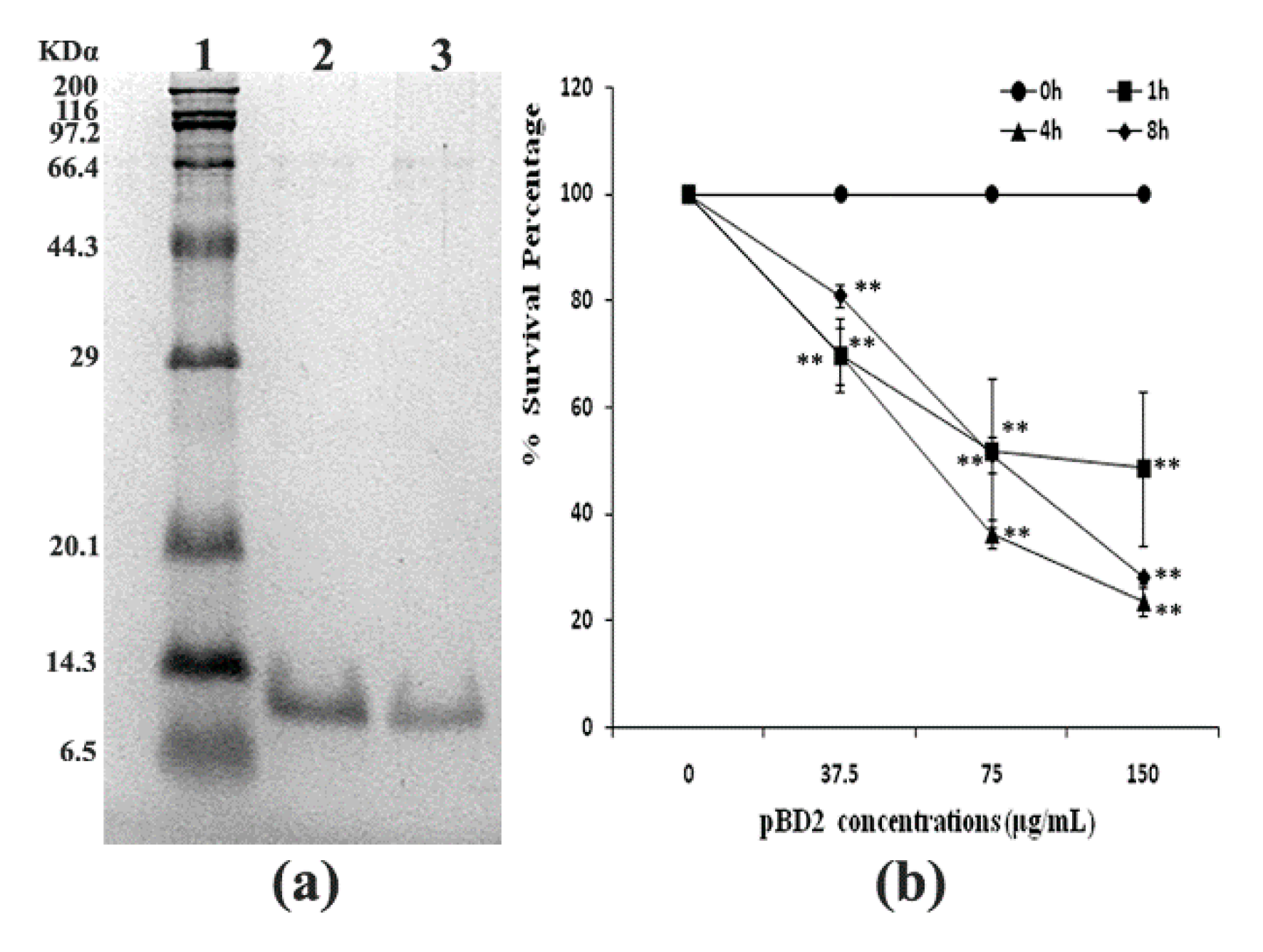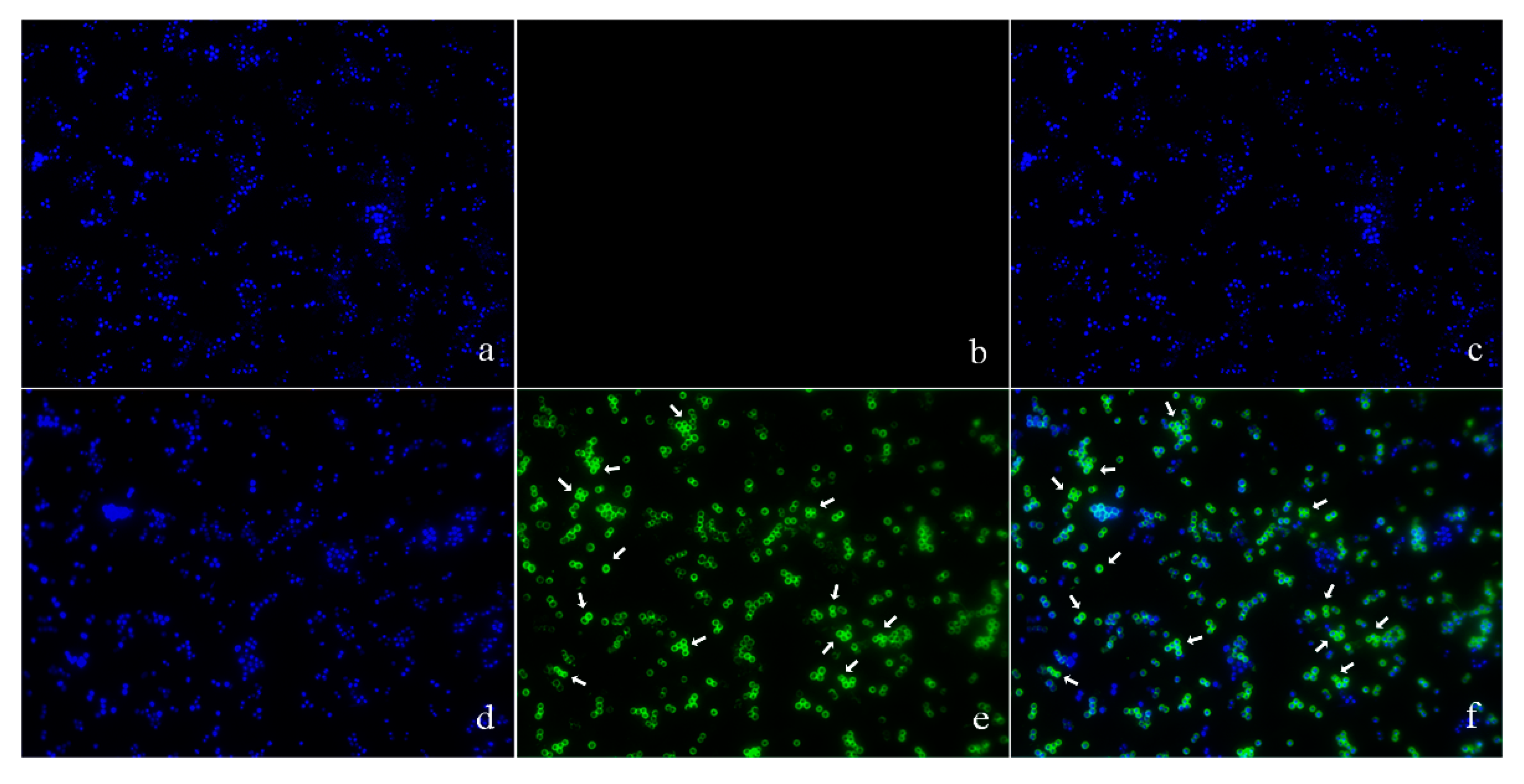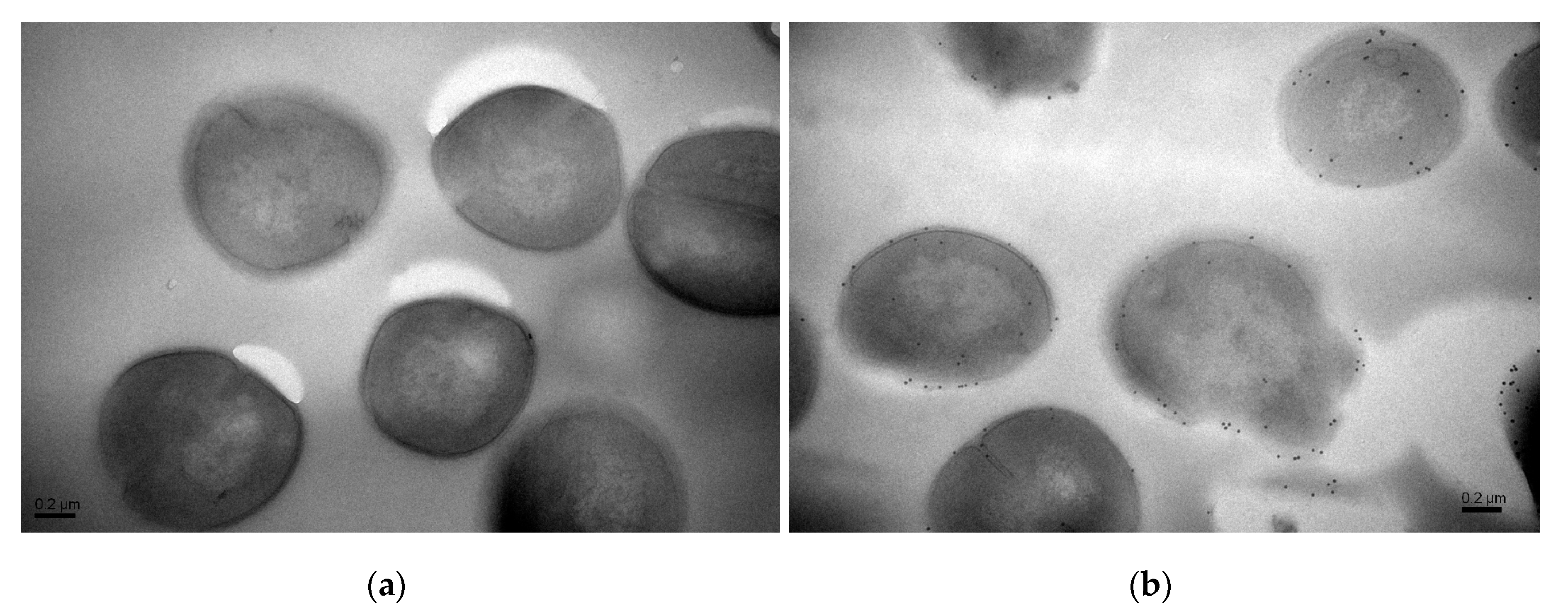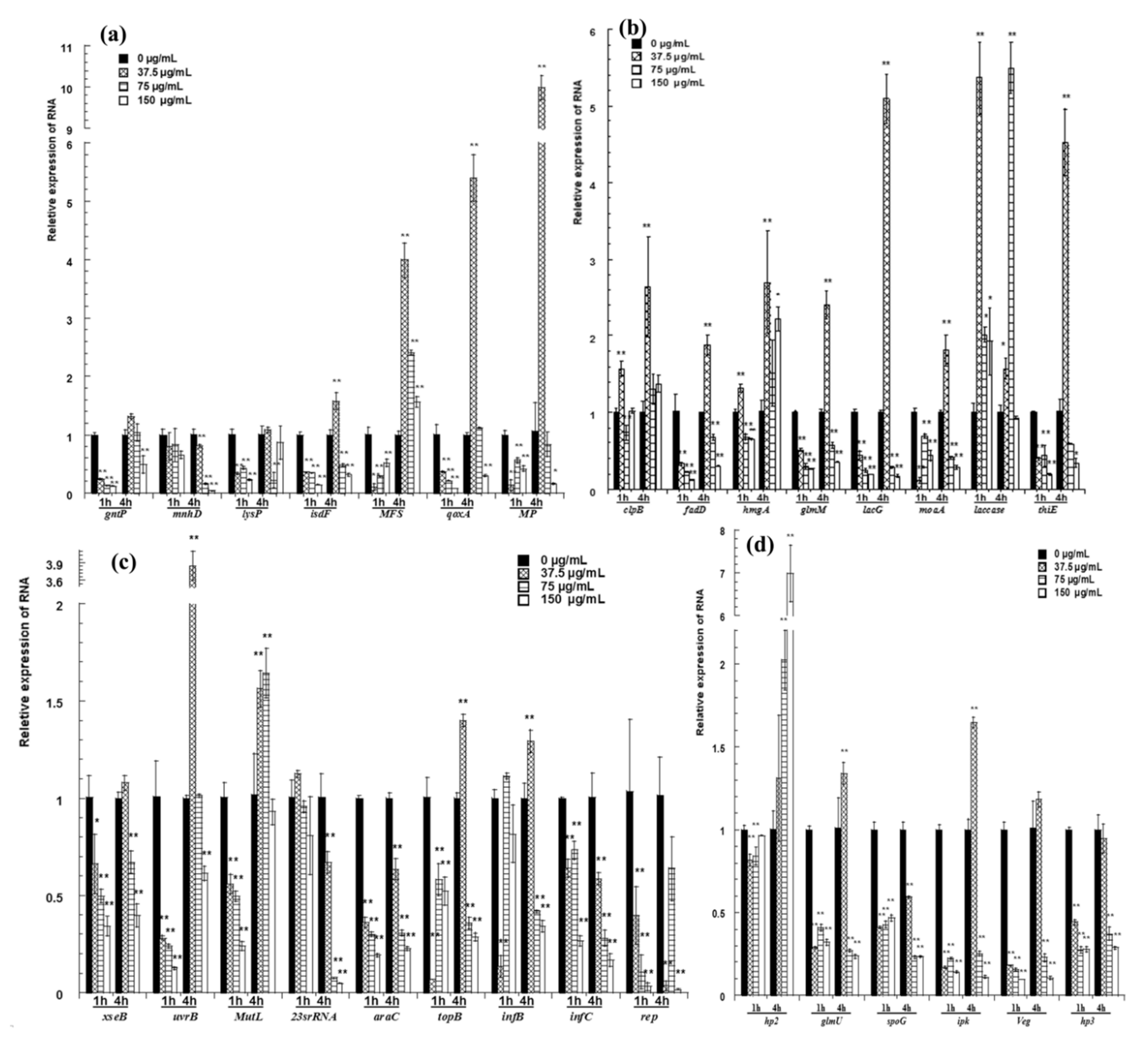Antimicrobial Mechanism of pBD2 against Staphylococcus aureus
Abstract
:1. Introduction
2. Results
2.1. Antibacterial Activity of pBD2
2.2. Morphological Changes in Bacteria
2.3. Localization of pBD2 Peptides
2.4. Identification of Differentially Expressed Gene Fragments by ACP (Annealing Control Primer)-Based RT-PCR
2.5. Analysis of DEGs
2.6. qRT-PCR Confirmation for Selected Genes
2.7. Gel Retardation Assay of pBD2 Binding to DNA
3. Discussion
4. Materials and Methods
4.1. Preparation of Porcine Beta Defensin 2
4.2. Bacteria with pBD2 Treatment
4.3. Morphological Changes in S. aureus
4.4. Localization of pBD2 Peptides
4.5. RNA Extraction
4.6. Identification and Analysis of DEGs
4.7. Quantitative Real-Time PCR
4.8. Gel Retardation Assay
4.9. Statistical Analysis
5. Conclusions
Supplementary Materials
Author Contributions
Funding
Acknowledgments
Conflicts of Interest
References
- Peschel, A.; Sahl, H.G. The co-evolution of host cationic antimicrobial peptides and microbial resistance. Nat. Rev. Microbiol. 2006, 4, 529–536. [Google Scholar] [CrossRef]
- Lehrer, R.; Ganz, T. Defensins of vertbrate animal. Curr. Opin. Immunol. 2002, 14, 96–102. [Google Scholar] [CrossRef]
- Silva, J.P.; Appelberg, R.; Gama, F.M. Antimicrobial peptides as novel anti-tuberculosis therapeutics. Biotechnol. Adv. 2016, 34, 924–940. [Google Scholar] [CrossRef] [Green Version]
- Sang, Y.; Patil, A.A.; Zhang, G.; Ross, C.R.; Blecha, F. Bioinformatic and expression analysis of novel porcine beta-defensins. Mamm. Genome 2006, 17, 332–339. [Google Scholar] [CrossRef]
- Choi, M.K.; Le, M.T.; Nguyen, D.T.; Choi, H.; Kim, W.; Kim, J.H.; Chun, J.; Hyeon, J.; Seo, K.; Park, C. Genome-level identification, gene expression, and comparative analysis of porcine β-defensin genes. BMC Genet. 2012, 13, 98. [Google Scholar] [CrossRef] [Green Version]
- Li, C.L.; Xu, T.T.; Chen, R.B.; Huang, X.X.; Zhao, Y.C.; Bao, Y.Y.; Zhao, W.D.; Zheng, Z.Y. Cloning, expression and characterization of antimicrobial porcine beta defensin 1 in Escherichia coli. Protein Expr. Purif. 2013, 88, 47–53. [Google Scholar] [CrossRef]
- Li, C.L.; Zhao, Y.C.; Song, X.Y.; Huang, X.X.; Zhao, W.D. Molecular cloning, expression and characterization of the porcine beta defensin 2 in E. coli. Protein Pept. Lett. 2012, 20, 715–723. [Google Scholar] [CrossRef]
- Veldhuizen, E.J.; Rijnders, M.; Claassen, E.A.; van Dijk, A.; Haagsman, H.P. Porcine beta-defensin 2 displays broad antimicrobial activity against pathogenic intestinal bacteria. Mol. Immunol. 2008, 45, 386–394. [Google Scholar] [CrossRef] [PubMed]
- Xie, K.; Xie, H.; Su, G.; Chen, D.; Yu, B.; Mao, X.; Huang, Z.; Yu, J.; Luo, J.; Zheng, P.; et al. Beta-defensin 129 attenuates bacterial endotoxin-induced inflammation and intestinal epithelial cell apoptosis. Front. Immunol. 2019, 10, 2333. [Google Scholar] [CrossRef] [PubMed]
- Su, G.; Xie, K.; Chen, D.; Yu, B.; Huang, Z.; Luo, Y.; Mao, X.; Zheng, P.; Yu, J.; Luo, J.; et al. Differential expression, molecular cloning, and characterization of porcine beta defensin 114. J. Anim. Sci. Biotechnol. 2019, 10, 60. [Google Scholar] [CrossRef] [PubMed]
- Tang, Z.; Xu, L.; Shi, B.; Deng, H.; Lai, X.; Liu, J.; Sun, Z. Oral administration of synthetic porcine beta-defensin-2 improves growth performance and cecal microbial flora and down-regulates the expression of intestinal toll-like receptor-4 and inflammatory cytokines in weaned piglets challenged with enterotoxigenic Escherichia coli. Anim. Sci. J. 2016, 87, 1258–1266. [Google Scholar] [CrossRef]
- Han, F.; Zhang, H.; Xia, X.; Xiong, H.; Song, D.; Zong, X.; Wang, Y. Porcine beta-defensin 2 attenuates inflammation and mucosal lesions in dextran sodium sulfate-induced colitis. J. Immunol. 2015, 194, 1882–1893. [Google Scholar] [CrossRef]
- Yang, X.; Cheng, Y.T.; Tan, M.F.; Zhang, H.W.; Liu, W.Q.; Zou, G.; Zhang, L.S.; Zhang, C.Y.; Deng, S.M.; Yu, L.; et al. Overexpression of porcine beta-defensin 2 enhances resistance to actinobacillus pleuropneumoniae infection in pigs. Infect. Immun. 2015, 83, 2836–2843. [Google Scholar] [CrossRef] [Green Version]
- Huang, C.; Yang, X.; Huang, J.; Liu, X.; Jin, H.; Huang, Q.; Li, L.; Zhou, R. Porcine beta-defensin 2 provides protection against bacterial infection by a direct bactericidal activity and alleviates inflammation via interference with the TLR4/NF-kappaB pathway. Front. Immunol. 2019, 10, 1673. [Google Scholar] [CrossRef] [PubMed] [Green Version]
- Tang, M.; Hong, M. Structure and mechanism of β-hairpin antimicrobial peptides in lipid bilayers from solid-state NMR spectroscopy. Mol. BioSyst. 2009, 5, 317–322. [Google Scholar] [CrossRef] [PubMed] [Green Version]
- Zhang, Y.; Lu, W.; Hong, M. The membrane-bound structure and topology of a human α-defensin indicate a dimer pore mechanism for membrane disruption. Biochemistry 2010, 49, 9770–9782. [Google Scholar] [CrossRef] [PubMed] [Green Version]
- Sani, M.A.; Separovic, F. How membrane-active peptides get into lipid membranes. Acc. Chem. Res. 2016, 49, 1130–1138. [Google Scholar] [CrossRef] [PubMed]
- Nguyen, L.; Haney, E.; Vogel, H. The expanding scope of antimicrobial peptide structures and their modes of action. Trends Biotechnol. 2011, 29, 464–472. [Google Scholar] [CrossRef] [PubMed]
- Liu, W.; Dong, S.L.; Xu, F.; Wang, X.Q.; Withers, T.R.; Yu, H.D.; Wang, X. Effect of intracellular expression of antimicrobial peptide LL-37 on growth of escherichia coli strain TOP10 under aerobic and anaerobic conditions. Antimicrob. Agents Chemother. 2013, 57, 4707–4716. [Google Scholar] [CrossRef] [Green Version]
- Nan, Y.H.; Park, K.H.; Park, Y.; Jeon, Y.J.; Kim, Y.; Park, I.S.; Hahm, K.S.; Shin, S.Y. Investigating the effects of positive charge and hydrophobicity on the cell selectivity, mechanism of action and anti-inflammatory activity of a Trp-rich antimicrobial peptide indolicidin. FEMS Microbiol. Lett. 2009, 292, 134–140. [Google Scholar] [CrossRef] [Green Version]
- Peters, B.M.; Shirtliff, M.E.; Jabra-Rizk, M.A. Antimicrobial peptides: Primeval molecules or future drugs? PLoS Pathog. 2010, 6, e1001067. [Google Scholar] [CrossRef] [PubMed]
- Wang, X.; Teng, D.; Mao, R.; Yang, N.; Hao, Y.; Wang, J. Combined systems approaches reveal a multistage mode of action of a marine antimicrobial peptide against pathogenic Escherichia coli and its protective effect against bacterial peritonitis and endotoxemia. Antimicrob. Agents Chemother. 2017, 61, e01056-16. [Google Scholar] [CrossRef] [PubMed] [Green Version]
- Wang, Y.; Chen, C.; Hu, D.; Ulmschneider, M.; Ulmschneider, J. Spontaneous formation of structurally diverse membrane channel architectures from a single antimicrobial peptide. Nat. Commun. 2016, 7, 13535. [Google Scholar] [CrossRef] [PubMed] [Green Version]
- Runti, G.; Benincasa, M.; Giuffrida, G.; Devescovi, G.; Venturi, V.; Gennaro, R.; Scocchi, M. The mechanism of killing by the proline-rich peptide Bac7(1-35) against clinical strains of Pseudomonas aeruginosa differs from that against other Gram-negative bacteria. Antimicrob. Agents Chemother. 2017, 61, e01660-16. [Google Scholar] [CrossRef] [PubMed] [Green Version]
- Tong, S.Y.; Davis, J.S.; Eichenberger, E.; Holland, T.L.; Fowler, V.G., Jr. Staphylococcus aureus infections: Epidemiology, pathophysiology, clinical manifestations, and management. Clin. Microbiol. Rev. 2015, 28, 603–661. [Google Scholar] [CrossRef] [Green Version]
- Hartmann, M.; Berditsch, M.; Hawecker, J.; Ardakani, M.F.; Gerthsen, D.; Ulrich, A.S. Damage of the bacterial cell envelope by antimicrobial peptides gramicidin S and PGLa as revealed by transmission and scanning electron microscopy. Antimicrob. Agents Chemother. 2010, 54, 3132–3142. [Google Scholar] [CrossRef] [Green Version]
- Gee, M.L.; Burton, M.; Grevis-James, A.; Hossain, M.A.; McArthur, S.; Palombo, E.A.; Wade, J.D.; Clayton, A.H. Imaging the action of antimicrobial peptides on living bacterial cells. Sci. Rep. 2013, 3, 1557. [Google Scholar] [CrossRef]
- Zhu, X.; Shan, A.; Ma, Z.; Xu, W.; Wang, J.; Chou, S.; Cheng, B. Bactericidal efficiency and modes of action of the novel antimicrobial peptide T9W against Pseudomonas aeruginosa. Antimicrob. Agents Chemother. 2015, 59, 3008–3017. [Google Scholar] [CrossRef] [Green Version]
- Benincasa, M.; Scocchi, M.; Pacor, S.; Tossi, A.; Nobili, D.; Basaglia, G.; Busetti, M.; Gennaro, R. Fungicidal activity of five cathelicidin peptides against clinically isolated yeasts. J. Antimicrob. Chemother. 2006, 58, 950–959. [Google Scholar] [CrossRef] [Green Version]
- Hong, J.; Guan, W.; Jin, G.; Zhao, H.; Jiang, X.; Dai, J. Mechanism of tachyplesin I injury to bacterial membranes and intracellular enzymes, determined by laser confocal scanning microscopy and flow cytometry. Microbiol. Res. 2015, 170, 69–77. [Google Scholar] [CrossRef]
- Wang, Q.; Guo, P.; Wang, Z.; Liu, H.; Zhang, Y.; Jiang, S.; Han, W.; Xia, Q.; Zhao, P. Antibacterial mechanism of gloverin 2 from silkworm, Bombyx mori. Int. J. Mol. Sci. 2018, 19, 2275. [Google Scholar] [CrossRef] [PubMed] [Green Version]
- Sun, C.; Li, Y.; Cao, S.; Wang, H.; Jiang, C.; Pang, S.; Hussain, M.A.; Hou, J. Antibacterial activity and mechanism of action of bovine lactoferricin derivatives with symmetrical amino acid sequences. Int. J. Mol. Sci. 2018, 19, 2951. [Google Scholar] [CrossRef] [PubMed] [Green Version]
- Seefeldt, A.C.; Graf, M.; Perebaskine, N.; Nguyen, F.; Arenz, S.; Mardirossian, M.; Scocchi, M.; Wilson, D.N.; Innis, C.A. Structure of the mammalian antimicrobial peptide Bac7(1-16) bound within the exit tunnel of a bacterial ribosome. Nucleic Acids Res. 2016, 44, 2429–2438. [Google Scholar] [CrossRef] [PubMed] [Green Version]
- Shan, Z.; Zhu, K.; Peng, H.; Chen, B.; Liu, J.; Chen, F.; Ma, X.; Wang, S.; Qiao, K.; Wang, K. The new antimicrobial peptide SpHyastatin from the Mud Crab Scylla paramamosain with multiple antimicrobial mechanisms and high effect on bacterial infection. Front. Microbiol. 2016, 7, 1140. [Google Scholar] [CrossRef] [PubMed]
- Wei, L.; LaBouyer, M.A.; Darling, L.E.; Elmore, D.E. Bacterial spheroplasts as a model for visualizing membrane translocation of antimicrobial peptides. Antimicrob. Agents Chemother. 2016, 60, 6350–6352. [Google Scholar] [CrossRef] [PubMed] [Green Version]
- Gopalakrishna, Y.; Langley, D.; Sarkar, N. Detection of high levels of polyadenylate-containing RNA in bacteria by the use of a single-step RNA isolation procedure. Nucleic Acids Res. 1981, 9, 3545–3554. [Google Scholar] [CrossRef] [Green Version]
- Hwang, K.C.; Lee, H.Y.; Cui, X.S.; Kim, J.H.; Kim, N.H. Identification of maternal mRNAs in porcine parthenotes at the 2-cell stage: A comparison with the blastocyst stage. Mol. Reprod. Dev. 2005, 70, 314–323. [Google Scholar] [CrossRef]
- Han, S.H.; Odathurai Saminathan, S.; Kim, S.J. Insulin stimulates gene expression of ferritin light chain in osteoblast cells. J. Cell. Biochem. 2010, 111, 1493–1500. [Google Scholar] [CrossRef]
- Yang, Z.; Peng, Z.; Wei, S.; Yu, Y.; Cai, P. Identification of differentially expressed genes in three-pistil mutation in wheat using annealing control primer system. Gene 2011, 485, 81–84. [Google Scholar] [CrossRef]
- Pao, S.S.; Paulsen, I.T.; Saier, M.H., Jr. Major facilitator superfamily. Microbiol. Mol. Biol. Rev. 1998, 62, 1–34. [Google Scholar] [CrossRef] [Green Version]
- Dean, M.; Hamon, Y.; Chimini, G. The human ATP-binding cassette (ABC) transporter superfamily. J. Lipid Res. 2001, 42, 1007–1017. [Google Scholar] [CrossRef] [PubMed]
- Sass, V.; Pag, U.; Tossi, A.; Bierbaum, G.; Sahl, H.-G. Mode of action of human β-defensin 3 against Staphylococcus aureus and transcriptional analysis of responses to defensin challenge. Int. J. Med. Microbiol. 2008, 298, 619–633. [Google Scholar] [CrossRef] [PubMed]
- Wenzel, M.; Chiriac, A.I.; Otto, A.; Zweytick, D.; May, C.; Schumacher, C.; Gust, R.; Albada, H.B.; Penkova, M.; Kramer, U.; et al. Small cationic antimicrobial peptides delocalize peripheral membrane proteins. Proc. Natl. Acad. Sci. USA 2014, 111, E1409–E1418. [Google Scholar] [CrossRef] [PubMed] [Green Version]
- Roosild, T.P.; Castronovo, S.; Healy, J.; Miller, S.; Pliotas, C.; Rasmussen, T.; Bartlett, W.; Conway, S.J.; Booth, I.R. Mechanism of ligand-gated potassium efflux in bacterial pathogens. Proc. Natl. Acad. Sci. USA 2010, 107, 19784–19789. [Google Scholar] [CrossRef] [Green Version]
- Lee, H.; Hwang, J.S.; Lee, J.; Kim, J.I.; Lee, D.G. Scolopendin 2, a cationic antimicrobial peptide from centipede, and its membrane-active mechanism. Biochim. Biophys. Acta 2015, 1848, 634–642. [Google Scholar] [CrossRef] [Green Version]
- Yang, W.; Feng, J.; Xiang, F.; Xie, Z.; Zhang, G.; Sabatier, J.M.; Cao, Z.; Li, W.; Chen, Z.; Wu, Y. Endogenous animal toxin-like human beta-defensin 2 inhibits own K(+) channels through interaction with channel extracellular pore region. Cell. Mol. Life Sci. 2015, 72, 845–853. [Google Scholar] [CrossRef]
- Xie, Z.; Feng, J.; Yang, W.; Xiang, F.; Yang, F.; Zhao, Y.; Cao, Z.; Li, W.; Chen, Z.; Wu, Y. Human alpha-defensins are immune-related Kv1.3 channel inhibitors: New support for their roles in adaptive immunity. FASEB J. 2015, 29, 4324–4333. [Google Scholar] [CrossRef]
- Florin, T.; Maracci, C.; Graf, M.; Karki, P.; Klepacki, D.; Berninghausen, O.; Beckmann, R.; Vázquez-Laslop, N.; Wilson, D.; Rodnina, M.; et al. An antimicrobial peptide that inhibits translation by trapping release factors on the ribosome. Nat. Struct. Mol. Biol. 2017, 24, 752–757. [Google Scholar] [CrossRef]
- Graf, M.; Mardirossian, M.; Nguyen, F.; Seefeldt, A.C.; Guichard, G.; Scocchi, M.; Innis, C.A.; Wilson, D.N. Proline-rich antimicrobial peptides targeting protein synthesis. Nat. Prod. Rep. 2017, 34, 702–711. [Google Scholar] [CrossRef]
- Gagnon, M.; Roy, R.; Lomakin, I.; Florin, T.; Mankin, A.; Steitz, T. Structures of proline-rich peptides bound to the ribosome reveal a common mechanism of protein synthesis inhibition. Nucleic Acids Res. 2016, 44, 2439–2450. [Google Scholar] [CrossRef] [Green Version]
- Roy, R.; Lomakin, I.; Gagnon, M.; Steitz, T. The mechanism of inhibition of protein synthesis by the proline-rich peptide oncocin. Nat. Struct. Mol. Biol. 2015, 22, 466–469. [Google Scholar] [CrossRef] [PubMed] [Green Version]
- Haney, E.F.; Petersen, A.P.; Lau, C.K.; Jing, W.; Storey, D.G.; Vogel, H.J. Mechanism of action of puroindoline derived tryptophan-rich antimicrobial peptides. Biochim. Biophys. Acta 2013, 1828, 1802–1813. [Google Scholar] [CrossRef] [PubMed] [Green Version]
- Sass, V.; Schneider, T.; Wilmes, M.; Korner, C.; Tossi, A.; Novikova, N.; Shamova, O.; Sahl, H.G. Human beta-defensin 3 inhibits cell wall biosynthesis in Staphylococci. Infect. Immun. 2010, 78, 2793–2800. [Google Scholar] [CrossRef] [PubMed] [Green Version]
- Dosunmu, E.F.; Chaudhari, A.A.; Bawage, S.; Bakeer, M.K.; Owen, D.R.; Singh, S.R.; Dennis, V.A.; Pillai, S.R. Novel cationic peptide TP359 down-regulates the expression of outer membrane biogenesis genes in Pseudomonas aeruginosa: A potential TP359 anti-microbial mechanism. BMC Microbiol. 2016, 16, 192. [Google Scholar] [CrossRef] [PubMed] [Green Version]
- de la Fuente-Núñez, C.; Korolik, V.; Bains, M.; Nguyen, U.; Breidenstein, E.B.; Horsman, S.; Lewenza, S.; Burrows, L.; Hancock, R.E. Inhibition of bacterial biofilm formation and swarming motility by a small synthetic cationic peptide. Antimicrob. Agents Chemother. 2012, 56, 2696–2704. [Google Scholar] [CrossRef] [Green Version]
- Flemming, K.; Klingenberg, C.; Cavanagh, J.P.; Sletteng, M.; Stensen, W.; Svendsen, J.S.; Flaegstad, T. High in vitro antimicrobial activity of synthetic antimicrobial peptidomimetics against staphylococcal biofilms. J. Antimicrob. Chemother. 2009, 63, 136–145. [Google Scholar] [CrossRef]
- Duarte, A.F.S.; Ceotto-Vigoder, H.; Barrias, E.S.; Souto-Padron, T.; Nes, I.F.; Bastos, M. Hyicin 4244, the first sactibiotic described in staphylococci, exhibits an anti-staphylococcal biofilm activity. Int. J. Antimicrob. Agents 2018, 51, 349–356. [Google Scholar] [CrossRef]
- Yadavalli, S.S.; Carey, J.N.; Leibman, R.S.; Chen, A.I.; Stern, A.M.; Roggiani, M.; Lippa, A.M.; Goulian, M. Antimicrobial peptides trigger a division block in Escherichia coli through stimulation of a signalling system. Nat. Commun. 2016, 7, 12340. [Google Scholar] [CrossRef]
- Huang, L.; Leong, S.S.; Jiang, R. Soluble fusion expression and characterization of bioactive human beta-defensin 26 and 27. Appl. Microbiol. Biotechnol. 2009, 84, 301–308. [Google Scholar] [CrossRef]
- Schneider, V.A.; Coorens, M.; Ordonez, S.R.; Tjeerdsma-van Bokhoven, J.L.; Posthuma, G.; van Dijk, A.; Haagsman, H.P.; Veldhuizen, E.J. Imaging the antimicrobial mechanism(s) of cathelicidin-2. Sci. Rep. 2016, 6, 32948. [Google Scholar] [CrossRef]
- Bao, Y.Y.; Li, L.; Zhang, H.; Gao, C.Y.; Xiao, C.B.; Li, C.L. Preparation of polyclonal antibody against porcine beta defensin 2 and identification of its distribution in tissues of pig. Genet. Mol. Res. 2015, 14, 18863–18871. [Google Scholar] [CrossRef] [PubMed]
- Velivelli, S.L.S.; Islam, K.T.; Hobson, E.; Shah, D.M. Modes of action of a bi-domain plant defensin MtDef5 against a bacterial pathogen Xanthomonas campestris. Front. Microbiol. 2018, 9, 934. [Google Scholar] [CrossRef] [PubMed]
Sample Availability: Not available. |





| Sequence 1 | GeneFishing | Size (bp) | Protein |
|---|---|---|---|
| (371h 3-2)/(/37S4h 3-1/3-2/16/75S4h 7-1) | up/down | 193/196/300/209/188 | 23S ribosomal RNA. |
| 37S1h 15-2 | down | 84 | DNA mismatch repair protein MutL. |
| (37S1h/37S4h 20-1/75S1h/150S4h 20-1) | down/up | 228/219/220/216 | Formate-tetrahydrofolate ligase. |
| 37S4h 5 | up | 52 | Gluconate transporter/gluconate permease. |
| 37S4h 7-2 | up | 73 | 6-Phospho-beta-galactosidase; or intergenic sequence: one is a transposase family protein; the other one is a hypothetical protein (378 bp, 215 aa, HP3). |
| 37S4h 9-1 | up | 273 | Protein disaggregation chaperone/ATP-dependent chaperone protein ClpB. |
| 37S4h 11-2 | up | 24 | Membrane protein. |
| 37S 4h 12-2/12-1 | up | 34/29 | MFS transporter. |
| 37S4h 15-1 | up | 39 | Molybdenum cofactor biosynthesis protein A. |
| 37S4h 15 | up | 88 | Heme ABC transporter permease; or translation initiation factor IF-3; or replication-associated protein. |
| 75S1h 1 | down | 57 | RNA polymerase sigma factor RpoD. |
| 75S1h 4-1 | down | 26 | AraC family transcriptional regulator; or gamma-aminobutyrate permease. |
| 75S1h 5-1 | down | 199 | 3-Hydroxy-3-methylglutaryl-CoA reductase. |
| 75S1h 9 | up | 82 | Laccase. |
| 75S4h 11-1 | down | 124 | DNA topoisomerase III. |
| 75S1h 14 | down | 213 | Potassium-transporting ATPase C chain. |
| 75S4h 15-1 | down | 87 | Phosphoglucosamine mutase. |
| 75S4h 18-1 | down | 232/228 | Long-chain fatty acid--CoA synthetase. |
| 150S1h 15-2 | down | 70 | Exodeoxyribonuclease VII, small subunit. |
| 150S4h 1 | down | 60 | Na(+) H(+) antiporter subunit A/monovalent cation/H+ antiporter subunit A. |
| 150S4h 4-1 | down | 130 | Quinol oxidase polypeptide II, integral component of membrane. |
| 150S4h 5 | down | 166 | Translation initiation factor 2. |
| 150S4h 6 | up | 115 | O-Antigen ligase family protein or intergenic sequences: both are hypothetical proteins. |
| 150S4h 5/19 | down | 80/105 | Thiamine-phosphate pyrophosphorylase. |
| 150S4h 9 | down | 84 | Zn-dependent hydrolase. |
| 150S4h 9-1 | down | 98 | Na(+) H(+) antiporter subunit D/monovalent cation/H antiporter, subunit D. |
| 150S4h 9-2 | down | 54 | Excinuclease ABC subunit B or bacitracin ABC transporter permease. |
| 37S1h 15-1 | up | 60 | Intergenic sequence: one is glucosamine-1-phosphate acetyltransferase, the other is stage V sporulation protein G. |
| 150S4h 9-3 | up | 50 | Intergenic sequence: one is veg protein; the other is 4-diphosphocytidyl-2C-methyl-D-erythritol kinase. |
| 37S4h 20-2 | up | 136 | Hypothetical protein 1 (366 bp, 121 aa). |
| 75S1h 5-2 | down | 80 | Hypothetical protein 2 (396 bp, 131 aa). |
| Name | Main Functions | Positions | Abbreviations |
|---|---|---|---|
| Transporter | |||
| Na(+) H(+) antiporter subunit A | involved in ATP synthesis-coupled electron transfer | integral component of membrane | mnhA |
| Na(+) H(+) antiporter subunit D | involved in ATP synthesis-coupled electron transfer | integral component of membrane | mnhD |
| quinol oxidase polypeptide II | ATP synthesis-coupled electron transport chain, transport; respiratory chain oxidoreductase activity | integral component of membrane/plasma membrane | qoxA |
| gamma-aminobutyrate permease | amino acid transmembrane transport | integral component of membrane | lysP |
| gluconate transporter | gluconate transmembrane transport | integral component of membrane | gntP |
| MFS transporter | transmembrane transport | integral component of membrane | MFS |
| bacitracin ABC transporter permease | transport | integral component of membrane | bcrB |
| potassium-transporting ATPase C chain | potassium transport | integral component of membrane/plasma membrane | kdpB |
| membrane protein | transport | integral component of membrane | MP |
| heme ABC transporter permease | transmembrane transport | integral component of membrane/plasma membrane | isdF |
| DNA Repair, Transcription, and Translation | |||
| exodeoxyribonuclease VII, small subunit | exonucleolytic cleavage, DNA repair | in cytoplasm | xseB |
| excinuclease ABC subunit B | DNA repair, nucleotide excision repair, SOS response | in cytoplasm | uvrB |
| DNA mismatch repair protein MutL | components of mismatch repair complex, repair of mismatches in DNA | in cytoplasm | MutL |
| RNA polymerase sigma factor RpoD | transcription initiation from bacterial-type RNA polymerase promoter | in cytoplasm | rpoD |
| 23S ribosomal RNA | protein synthesis | in cytoplasm | 23srRNA |
| DNA topoisomerase III | releases the supercoiling and torsional tension of DNA during the DNA replication and transcription | in chromosomes | topB |
| AraC family transcriptional regulator | transcriptional regulator | in cytoplasm | araC |
| translation initiation factor 2 | the initiation of protein synthesis | in cytoplasm | infB |
| translation initiation factor 3 | the initiation of protein synthesis | in cytoplasm | infC |
| replication-associated protein | replication-associated | in cytoplasm | rep |
| Zn-dependent hydrolase | RNA processing; RNA phosphodiester bond hydrolysis | unknown, possibly in cytoplasm | zdh |
| Metabolism | |||
| protein disaggregation chaperone/ATP-dependent chaperone protein ClpB | nucleoside triphosphatase activity disaggregates misfolded and aggregated proteins; cell recovery from heat-induced damage. | in cytoplasm | clpB |
| long-chain fatty acid--CoA synthetase | involved in fatty acid and lipid metabolism, phospholipid biosynthetic process | inner membrane | fadD |
| 3-hydroxy- 3-methylglutaryl-CoA reductase | rate-controlling enzyme of the mevalonate pathway, non-sterol isoprenoids biosynthetic process | integral component of membrane | hmgA |
| phosphoglucosamine mutase | carbohydrate metabolic process, participates in both the breakdown and synthesis of glucose | unknown, possibly in cytoplasm | glmM |
| 6-phospho-beta-galactosidase | carbohydrate metabolism, lactose degradation | unknown, possibly in cytoplasm | lacG |
| molybdenum cofactor biosynthesis protein A | involved in the pathway of molybdopterin biosynthesis, redox action | molybdopterin synthase complex, possibly in cytoplasm | moaA |
| Laccase | formation or degradation of lignin | unknown, possibly in cytoplasm | laccase |
| thiamine-phosphate pyrophosphorylase | participates in thiamine metabolism, | unknown, possibly in cytoplasm | thiE |
| thiamine diphosphate biosynthesis | |||
| O-Antigen ligase family protein | ligase activity, biogenesis of the outer membrane | integral component of membrane | oal |
| formate-tetrahydrofolate ligase | participating in the transfer of one-carbon units, an essential element of various biosynthetic pathways | in cytoplasm | fhs |
| Protein beside Intergenic Sequences | |||
| glucosamine-1-phosphate acetyltransferase | plays an important role in maintenance of cell shape, involved in lipopolysaccharide and peptidoglycan biosynthetic processes | in cytoplasm | glmU |
| stage V sporulation protein G | participation in the barrier formation of spores | unknown | spoG |
| 4-diphosphocytidyl-2C-methyl-D-erythritol kinase | terpenoid biosynthetic process | unknown | ipk |
| isopentenyl diphosphate biosynthetic process | |||
| Veg protein | biofilm formation | unknown | Veg |
| hypothetical protein 3 (378 bp, 215 aa) | unknown | unknown | hp3 |
© 2020 by the authors. Licensee MDPI, Basel, Switzerland. This article is an open access article distributed under the terms and conditions of the Creative Commons Attribution (CC BY) license (http://creativecommons.org/licenses/by/4.0/).
Share and Cite
Zhang, K.; Zhang, H.; Gao, C.; Chen, R.; Li, C. Antimicrobial Mechanism of pBD2 against Staphylococcus aureus. Molecules 2020, 25, 3513. https://doi.org/10.3390/molecules25153513
Zhang K, Zhang H, Gao C, Chen R, Li C. Antimicrobial Mechanism of pBD2 against Staphylococcus aureus. Molecules. 2020; 25(15):3513. https://doi.org/10.3390/molecules25153513
Chicago/Turabian StyleZhang, Kun, Heng Zhang, Chunyu Gao, Ruibo Chen, and Chunli Li. 2020. "Antimicrobial Mechanism of pBD2 against Staphylococcus aureus" Molecules 25, no. 15: 3513. https://doi.org/10.3390/molecules25153513
APA StyleZhang, K., Zhang, H., Gao, C., Chen, R., & Li, C. (2020). Antimicrobial Mechanism of pBD2 against Staphylococcus aureus. Molecules, 25(15), 3513. https://doi.org/10.3390/molecules25153513






